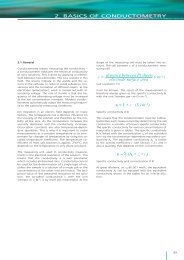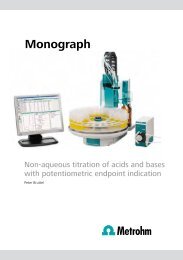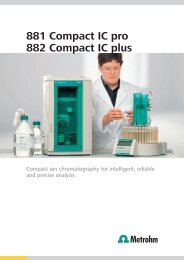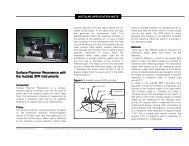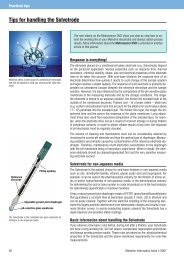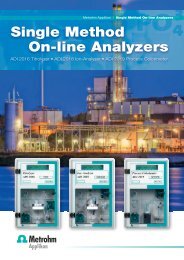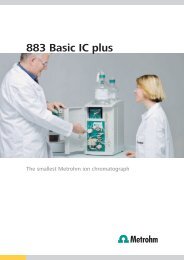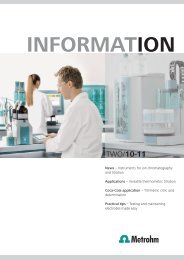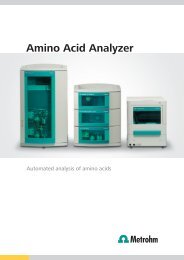What is the theoretical background of potentiometry? - Metrohm
What is the theoretical background of potentiometry? - Metrohm
What is the theoretical background of potentiometry? - Metrohm
You also want an ePaper? Increase the reach of your titles
YUMPU automatically turns print PDFs into web optimized ePapers that Google loves.
Calibrating a metal electrodeRedox-buffer solutions (6.2306.020) are used forquickly checking metal or redox electrodes. As <strong>the</strong>potential measured in a redox buffer solution <strong>is</strong> insensitiveto <strong>the</strong> electrode's surface condition, contamination<strong>of</strong> <strong>the</strong> metal electrode <strong>is</strong> <strong>of</strong>ten not recognized.For th<strong>is</strong> reason redox-buffer solutions are ra<strong>the</strong>r moresuitable for checking <strong>the</strong> reference electrode. If <strong>the</strong>potential <strong>is</strong> d<strong>is</strong>placed <strong>the</strong>n <strong>the</strong> metal electrode <strong>is</strong>contaminated, <strong>the</strong> redox buffer partly oxidized or <strong>the</strong>functioning <strong>of</strong> <strong>the</strong> reference electrode <strong>is</strong> affected.Under no circumstances should <strong>the</strong> indicated potentialbe set to <strong>the</strong> <strong>the</strong>oretical value.If measurements are made in weakly redox-bufferedsolutions <strong>the</strong>n a suitable pretreatment <strong>of</strong> <strong>the</strong> metalelectrode <strong>is</strong> recommended to adapt <strong>the</strong> surface conditionas much as possible to <strong>the</strong> measurement conditions(abrasive pretreatment: carefully clean <strong>the</strong>electrode with abrasive paste, reductive or oxidativepretreatment: switch electrode as anode or cathode;see also electrode data sheet). The reference electrodecan ei<strong>the</strong>r be checked against a second referenceelectrode that has already been checked inbuffer solutions 4 and 7 (response behavior and referencepotential) or by using <strong>the</strong> redox buffer.In <strong>the</strong> literature <strong>the</strong> so-called standard redox potentialsE 0 can usually be foundCl 2 (g) + 2e - → 2 Cl -Fe 3+ + e - → Fe 2+Cd 2+ + 2e - → Cd 2-E 0 = +1.359 VE 0 = +0.771 VE 0 = -0.403 VThe zero point <strong>of</strong> <strong>the</strong>se systems <strong>is</strong> defined (arbitrarily)with <strong>the</strong> standard hydrogen electrode (SHE) which <strong>is</strong>assigned a standard potential <strong>of</strong> 0 mV. If electrons arereleased by a redox system to <strong>the</strong> SHE <strong>the</strong>n th<strong>is</strong> <strong>is</strong>reduced and <strong>the</strong> redox pair receives a negative sign;if electrons are accepted <strong>the</strong>n <strong>the</strong> SHE <strong>is</strong> oxidized and<strong>the</strong> result <strong>is</strong> a redox potential with a positive sign. Thestandard hydrogen reference electrode <strong>is</strong> difficult tohandle. The specifications <strong>of</strong> <strong>the</strong> SHE stipulate that aplatinized platinum wire must be used; th<strong>is</strong> <strong>is</strong> locatedin a stream <strong>of</strong> hydrogen gas at a partial hydrogenpressure <strong>of</strong> 1.0 bar, and that <strong>the</strong> activity <strong>of</strong> <strong>the</strong> hydrogenions in <strong>the</strong> solution in which <strong>the</strong> platinizedplatinum wire <strong>is</strong> immersed <strong>is</strong> to be exactly 1.00 mol/L.The normal alternative <strong>is</strong> <strong>the</strong> Ag/AgCl/KCl referenceelectrode, which has a potential E 0 = +0.2076 V atc(KCl) = 3 mol/L and T = 25 °C. The <strong>Metrohm</strong> redoxstandard (6.2306.020) can be used for checking separateand combined metal electrodes. Platinum andgold electrodes toge<strong>the</strong>r with <strong>the</strong> Ag/AgCl/KCl referenceelectrode (c(KCl) = 3 mol/L and T = 20 °C)produce a potential <strong>of</strong> +250 ± 5 mV.Table 5: Measuring data for 6.2306.020 redox standard as a function <strong>of</strong> <strong>the</strong> temperatureTemp. (°C) 10 20 25 30 40 50 60 70mV ± 5 +265 +250 +243 +236 +221 +207 +183 +178pH ± 0.05 7.06 7.02 7.00 6.99 6.98 6.97 6.97 6.98If instead <strong>of</strong> an Ag/AgCl/KCl reference electrodec(KCl) = 3 mol/L an Ag/AgCl/KCl reference electrodec(KCl) = sat. <strong>is</strong> used for <strong>the</strong> measurement <strong>the</strong>n at25 °C a correction <strong>of</strong> +10 mV must be applied; if <strong>the</strong>measurement <strong>is</strong> made using an Hg/Hg 2 Cl 2 /KCl calomelreference electrode, which for toxicological reasons<strong>is</strong> no longer available from <strong>Metrohm</strong>, <strong>the</strong> correctionto be applied <strong>is</strong> -37 mV.The Titrodes are checked by a standard titration as nosuitable calibration or buffer solutions are available.For example, <strong>the</strong> certified ion standard c(NaCl) = 0.1mol/L (6.2301.010) can be titrated with a silver nitratestandard solution.81




